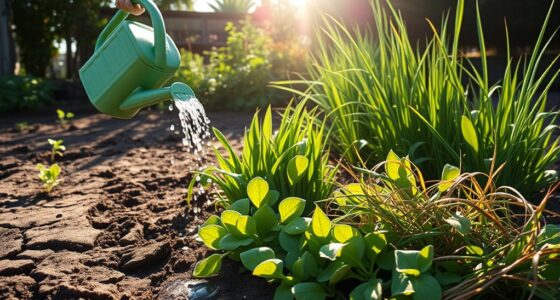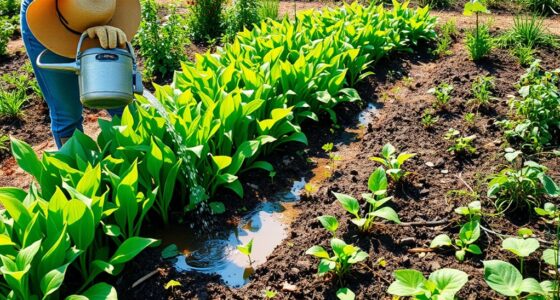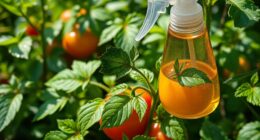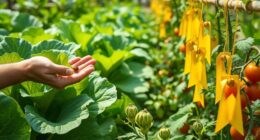To avoid common gardening mistakes, start with proper soil testing and add organic matter to boost fertility and drainage. Monitor pests early and use integrated pest management instead of relying solely on chemicals. Water your plants appropriately, adjusting for weather, and guarantee proper spacing for air circulation. Be patient, observe your garden regularly, and respond to your plants’ needs. Keep these tips in mind, and you’ll set yourself up for gardening success. There’s more to discover that can make your garden thrive.
Key Takeaways
- Avoid neglecting soil testing and amendments to ensure proper pH and nutrient levels.
- Don’t ignore early signs of pests; use integrated and organic pest management methods.
- Water appropriately, balancing watering frequency and plant needs, and maintain proper spacing for airflow.
- Practice patience, observe plants regularly, and adjust care based on their growth and environmental changes.
- Maintain consistent garden care by planning, monitoring, and responding proactively to issues.

Starting your gardening journey can be exciting, but beginners often make mistakes that hinder their plants’ growth. One of the most common errors is neglecting proper soil preparation. Healthy plants start with good soil, so it’s essential you invest time in improving your soil before planting. Instead of just digging holes and throwing in seeds or seedlings, test your soil’s pH and nutrient levels. You might need to add compost or organic matter to enhance fertility and drainage. Poorly prepared soil can lead to weak root systems, stunted growth, and an increased risk of pests and diseases. Remember, healthy soil supports healthy plants, so don’t skip this pivotal step. Additionally, understanding soil testing can help you make more informed decisions about amendments and fertilization.
Healthy plants start with well-prepared soil—test, amend, and nourish for best growth.
Another mistake beginners make is overlooking pest management. Pests can quickly become a nightmare if you ignore early signs of infestation. Instead of waiting until your plants are visibly damaged, take preventive measures from the start. Use organic pest control methods like introducing beneficial insects or applying natural sprays, and keep your garden clean by removing debris and fallen leaves that can harbor pests. Regularly inspecting your plants helps you catch problems early, making pest management easier and more effective. Ignoring pests or relying solely on chemical pesticides can lead to resistance and harm beneficial insects, so adopting integrated pest management techniques is your best approach.
Many beginners also forget that consistent watering and proper spacing are essential. Overwatering can drown roots, while underwatering stresses plants and makes them more susceptible to pests and diseases. Proper spacing ensures good air circulation, reducing humidity around your plants, which discourages fungal growth and pests. It’s crucial to learn your specific plants’ watering needs and stick to a routine, especially during hot or dry spells. Proper watering and spacing work hand-in-hand with soil preparation and pest management to give your garden the best chance to thrive.
Finally, don’t underestimate the importance of patience and observation. Gardening isn’t about quick results; it’s about understanding your plants and responding to their needs. Keep an eye on how your plants are doing, and adjust your practices accordingly. Avoid the temptation to over-fertilize or rush things, as this can lead to more problems. Instead, focus on creating a balanced, healthy environment by paying attention to soil health, managing pests proactively, and maintaining proper care routines. Doing so helps you avoid many common beginner mistakes and sets a solid foundation for a lush, productive garden.
Frequently Asked Questions
How Often Should I Water My New Garden Plants?
You should establish a consistent watering schedule to guarantee proper plant hydration. Typically, new garden plants need watering every 2-3 days, but this depends on the weather and soil type. Check the soil moisture regularly—if it feels dry a few inches down, it’s time to water. Remember, overwatering can harm your plants, so aim for moist but not waterlogged soil to keep your garden thriving.
What Is the Best Time of Day to Plant Seeds?
Did you know planting seeds during the early morning or late afternoon can boost germination success by 20%? You should aim to plant seeds during your local planting season, when soil is warm but not scorching. This helps make certain proper seed spacing and healthy growth. Avoid midday planting, as heat can stress young seedlings. Timing your planting this way gives your garden the best start possible.
How Can I Prevent Pests Without Using Chemicals?
To prevent pests naturally, start with natural pest control methods like encouraging beneficial insects and using organic repellents. Companion planting is also effective; plant pest-repelling herbs like basil or marigolds near your vegetables. Keep your garden healthy by proper watering and removing diseased plants. These strategies create an environment that pests dislike, reducing their presence without chemicals. Regularly monitor your garden to catch issues early and maintain a thriving, pest-free space.
Which Soil Type Is Ideal for Most Vegetables?
For most vegetables, loamy soil is ideal because it retains moisture while draining well. To guarantee your soil’s quality, do soil testing to check pH and nutrient levels. Incorporate composting techniques to enrich your soil naturally, boosting fertility and structure. This approach helps create a healthy growing environment, promotes strong plant growth, and reduces the risk of pests and diseases, making your vegetable garden more productive and sustainable.
How Do I Know When to Harvest My Crops?
Think of your crops like a masterpiece waiting to be revealed. To know when to harvest, look for maturity indicators like color, size, and firmness. For example, tomatoes should be fully red and slightly soft, while carrots reach their ideal size. Timing is key—you’ll want to pick when they’re ripe but not overripe. Trust these signs to guarantee you harvest at the perfect moment, maximizing flavor and yield.
Conclusion
Avoid these common mistakes, and your garden will flourish like a vibrant tapestry of colors and textures. Picture your plants basking in perfect sunlight, roots deep in healthy soil, and blooms bursting with life. With a little attention and care, you’ll turn your outdoor space into a lush, thriving sanctuary. Keep learning, stay patient, and watch your garden grow into a beautiful haven where nature’s magic unfolds with every passing day.









